Stacey D. Atkinson's Blog, page 8
November 29, 2013
When it's time to pivot your business
I was flying home from a weekend of selling my book at a big Christmas fair on the East Coast, when I read a fascinating article in Entrepreneur Magazine entitled, "Have you reached your pivot point?: Six signs it may be time to turn your startup in a new direction" by Paula Andruss. The more I read, the more interested I became in the principles of pivot and how this could apply to an author or small publishing company.
Did you know that some of the biggest brands in the world started off as completely different companies, and when they realized the business wasn't working they pivoted to a new direction to achieve astronomical success? For example, the daily-deal site Groupon started as The Point, a fundraising website; Facebook started as Facemash, a website to vote who was better looking between two photos; the image-hosting website Flickr started as the online game Never Ending; and YouTube started as the online video-dating site Hook Up. All of these companies started with a goal in mind but then along the way realized they were much better at doing something else. This is the concept behind a business pivot.
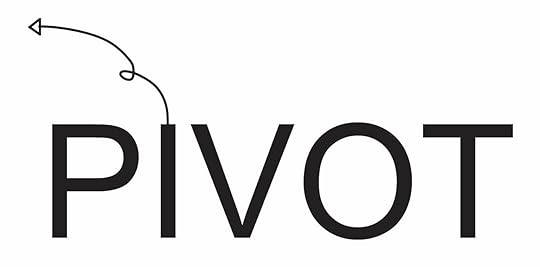
Here are the top six ways to know when you need to make a business pivot, as explained in the article.
1. One piece works better than the whole. Sometimes a business can accidentally stumble upon something that it's really good at and you realize there's more potential for growth and sales in that area than in the original business idea. This can be true for authors who love to write books, but they may also be a fantastic conference speaker.
2. You misjudged your market. You think you've come up with the next big solution (ebooks) to a dying industry (paperbacks) only to realize that book buyers aren't quite ready for the shift and aren't interested in your new product.
3. You're missing industry standards. Every industry has a typical time in which they can expect to acquire customers. For example, I had a graphic designer once tell me that it takes 12 months for her to gain a customer after the first meeting; and a music producer recently told me his customer cycle is about 2 years. When it comes to book buying, let's say it takes 2 months from the time a book reader receives a personal recommendation or a coupon code to the time they actually buy the book. If you are not realizing sales within those 2 months, then it should be a red flag that you are outside of your industry norm and something has to change (e.g. price?)
4. The money's not there. The article gives the example of a company that started as a music-lovers website to create fantasy record labels to 'sign' artists they like. But when the money wasn't there to keep the site going, the company made a pivot to become an analytics company for artists, producers, and labels. Sometimes a good idea just isn't a money-making business.
5. A competitor is doing it better. Amazon was not the first online company to sell books, but they are now the biggest because they do it better than anyone else.
6. The thrill is gone. You have to be passionate about your business because no one will care about it as much as you, and you have to be prepared to work some long, brutal hours to get it off the ground. If you get to the point where you don't want to do it anymore, it's time to pivot.
I hope this article provided you with the inspiration to keep building your own business empire!
Stacey D. Atkinson is the author of the newly released novel Stuck , which she published via her independent company Mirror Image Publishing .
November 21, 2013
How to sell your book at a Christmas Fair
"It's the most wonderful time of the year..." which means there are oodles of new opportunities to sell your book. Not only are more people shopping during the holiday season, but books have traditionally been the go-to Christmas gift. So as I prepare to fly back to my hometown this weekend to participate in the wildly popular Turners Christmas fair at the Moncton Coliseum, I thought I'd share with you the essentials that I'm packing to get me through the 3-day marathon weekend of selling and signing books.
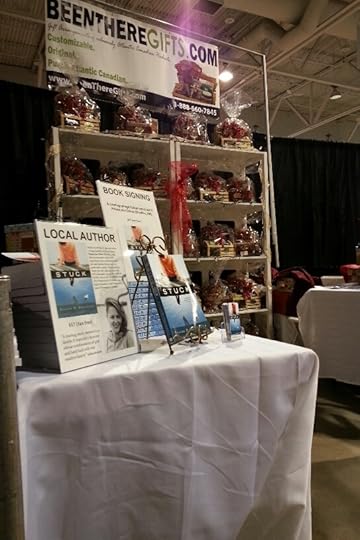
I decided to participate in the Turners Christmas fair this year because I've always gotten great support from my hometown (Moncton, NB) and because I was invited to share a booth with my sister who is promoting her own company, Been There Gifts, selling awesome Atlantic Canadian products. My fiction novel fits in perfectly with the overall Maritime theme, since the book is a coming-of-age story about a young Acadian woman living in the nearby town of Shediac (Pointe-du-Chene, NB), otherwise known as the Lobster Capital of the World (serious!)
Here is a list of the essential things you need to know about promoting your book at a 3-day Christmas fair.
1. Combine and conquer. Consider sharing your booth with someone else, since it can be a lot of work and a bit overwhelming to plan the logistics of an entire booth all by yourself. If you share the space with someone who has a complementary product, you'll draw in more people, too.
2. Sign up for Square. Make your life easy and accept credit card purchases directly on your cell phone by using a Square reader. All you need to do is sign up in advance for Square, download the app, and ensure that you have a data plan on your phone (as wifi will be unreliable in a large coliseum venue). You should also prepare for cash sales by rounding off your book price so you won't be dealing with any coins, and carry a small float of loonies ($1), toonies ($2), and five-dollar bills.
3. Eat and hydrate. Pack a cooler bag with bottles of water and some healthy snacks, such as fruit and nuts. Avoid the crankies and nourish yourself along the way. If you are so lucky as to be run-off-your-feet busy with sales, you may not have time to take a proper dinner break, so at least you'll have something to grab in the meantime.
4. Pens, pens, pens. You can't have enough pens, especially since they will grow legs and walk off on their own into the sunset together.
5. Call to action. Create enticing posters with strong 'call to action' messages so people will be more inclined to buy your book. For example, you can offer 'tax free' or '20% off' or 'signed copy', which readers can't get when they buy your book online or at the bookstore.
6. Ship inventory ahead of time. Make your best guess at how many books you'll need (e.g. 150-200 for a 3-day fair) and ship them in advance to the venue, or to a friend's house in the same city. Or, if need be, you can bring boxes of books with you in your suitcase on the plane, then use your suitcase as a dolly to wheel your books into the fair. Example: Air Canada allows your first bag to weigh 23kilos (depending on the size of your book, this could be approx. 55 books), and you can add a second bag weighing 23kilos (or forget the suitcase and just bring the box of books) for a fee of $20.
7. Invite people. Create 'events' on all your social media channels including Facebook, Goodreads, Amazon's Author Central, Linked-In, and Google+. If you have the time and money, you can also consider creating an ad on Facebook.
8. Dress comfortably. Wear comfortable clothes and shoes (these large venues often have concrete floors), and bring a sweater, too. Dress for success!
9. Music. It's a Christmas fair, y'all, so why not invite people over to your booth with the wonderful, uplifting sounds of a Big Band Christmas. Plus, the tunes will help keep you in the holiday spirit, too.
...and my number one essential item for a book signing is
10. Lip balm!
Have a great book signing weekend!
Stacey D. Atkinson is the author of the newly released novel Stuck , which she published via her independent company Mirror Image Publishing .
November 15, 2013
I thought ebooks were taking over the world?
Ever heard the saying “Can’t see the forest for the trees?” It can be all too easy to work day in and day out on a project, only to lose sight of the big picture. That’s why I was so excited to be on holiday this week in southern Spain, keeping me off the grid for almost a full week, so I could think about what the heck it is I’m doing with my writing and publishing business.
In my home office, I have a gigantic business plan written on a gigantic roll of paper on the wall like a map. I look up at it from time to time to make sure I’m on track and to remind myself not to sweat the small stuff. Whenever I get stuck on a problem, the business map helps me to see that it’s only a small blip on the radar, and I need to just solve the problem already and move on without wasting any more precious time on it.
However, I realized that it’s been a while since I put my business plan together and I haven’t yet stepped back to ask the question: Am I still on the right track? Is it time to re-adjust my strategy? My main goal was to start an independent e-publishing company to take over the world to primarily publish the books I write and to take advantage of the rapidly transforming publishing industry.
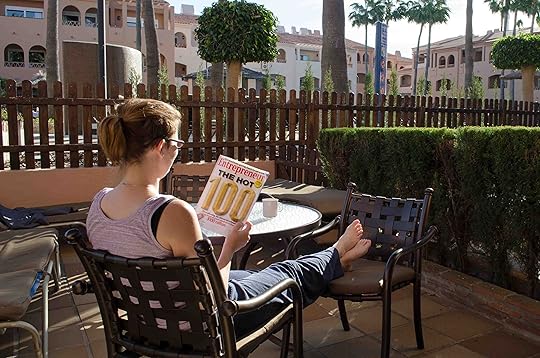
Now that I've had several days in the sun to think, lie around, eat, and drink—basically exhibiting general sloth-like behavior with the occasional walk for good measure—I've been able to shake my head out of the everyday drone of work and rise above the noise to gain perspective on the big picture. Here are some ironies I've noticed in my business that beg the question: Do I need to shift gears?
- I started an independent e-publishing company (e.g. ebooks), yet most of my sales are coming from the paperback version of my novel. What gives with that? I thought ebooks were taking over the world and that I was riding the wave along with the rest of the innovators?
- I thought the following equation was true, which it is not: "marketing = book sales". Identifying and targeting your market is a tricky business.
- It’s hard to be a writer and publisher at the same time because these roles are both full-time jobs. This lends itself, unfortunately, to strict scheduling of time.
- Social media is my friend and my foe. I love spending time on Twitter, Facebook, Tumblr, etc., but that’s just the problem--time is precious. Learning about trends and chatting with like-minded people online is time I’m not writing my next book (but it feels so gooooood...)
Fortunately, there are some things I learned to be true over this past year, which proved to me that at least I do have some business sense (yes!).
- A book is judged by its cover—a good book cover is appreciated by readers and the industry alike, and will increase sales.
- Picking up the phone and actually speaking with someone (as opposed to email) is still very efficient and reaps great results. Old-school one-on-one communication still holds its weight in gold. People ask me how I got my book into bookstores and I say, “I called and asked the manager if the store would carry my book and he said yes.”
- You can’t do everything yourself. Outsource all that you can, so that you can spend more time doing what makes you a great writer and entrepreneur.
Needless to say, this vacation has given me some much needed time and space to think, and I learned that I've got some re-jigging to do with my business plan when I get home. Specifically, I need to be more efficient in my business practices, I need to write more freely and more often, and I need to continually seek out my market.
Piece of cake, right!
Stacey D. Atkinson is the author of the newly released novel Stuck, which she published via her independent company Mirror Image Publishing.
November 8, 2013
What to expect when you're the guest author at a book club
This week I had the best experience ever--I was the guest of honour at a book club to discuss my book! The book club members have been meeting every month for the past six years and this was the first time they'd ever had an author visit. They were thrilled, as was I, and we drank and talked and ate for over three hours! It was such a great evening spent with 8 interesting women who loved to read. However, over the course of the night, I was completely surprised at what they actually wanted to know from me...
I arrived at the book club prepared, I thought, with reading questions, fun examples of the research materials I'd used in writing the book, a quiz, and of course, a hostess gift (i.e. wine)! But as the evening progressed, I was surprised at the actual things that people were interested in. Here's what they wanted to know.
Questions You'll Likely Receive During a Guest Appearance at a Book Club
- How do you write a book? How do you write chapters and figure out the ending, and how do you come up with characters?
- How did you get your book into Chapters bookstore? How does that happen?
- Did you write an alternate ending? If so, what was it?
- How do you publish a book?
- How do you chose the font inside the book? How do you chose the cover design? What is a stock photo? How did you find your cover designer?
- Is the book setting real?
- What does an editor do? How did you find your editor?
- What is the role of libraries in book discovery?
- How do you make an ebook? How do you sell it online?
Needless to say, I truly felt like a guest of honour and had a fantastic time sharing my knowledge with the book club ladies. Even though I had prepared to talk about the book and the characters, I ended up spending most of the evening talking about how to write and publish a book, which I think is a wonderment to so many people. And I can still remember how it was a mystery to me, too, not so long ago. I have always felt that bringing a book from concept to reality and seeing it on a bookstore shelf was a truly amazing thing, and now I know that there are lots of readers out there who feel the same way, too!
Onward and upward, y'all.
Stacey D. Atkinson is the author of the newly released novel Stuck, which she published via her independent company Mirror Image Publishing.
November 1, 2013
Blog tours for book discovery
One guaranteed way to get people thinking about your book is to conduct a blog tour. A blog tour is when you, the author, schedule a series of posts about your book on a series of blogs over a 2-4 week period. It creates a concentrated time when people will be talking about your book, which should lead to greater discovery...which just might lead to sales!

Setting up a blog tour is pretty easy, but I will be honest with you, it takes time. Give yourself a couple of weeks to research and schedule the tour and to write guest posts; and then once the tour gets underway, you'll need time to monitor reader comments on the blog sites and to coordinate the contest giveaways. In the end, what do you have to lose?
Listed below are some great blogs to get you started on learning 'how to' organize a blog tour. In a nutshell, the basic steps are:
1. Research blogs that review books in your genre
2. Set a date for your tour (preferably one blog every other day over 4 weeks)
3. Create a spreadsheet of blog contact info
4. Create a list of what you have to offer e.g. a guest blog post, author photo, signed book for a giveaway (or ebook)
5. Be respectful and contact all blogs with your request for a tour on their site
6. Write guest blog posts for the tour
7. Monitor the tour and comment on reader comments
8. Mail-out contest giveaways
For a more comprehensive look at how to plan a blog tour, check out these helpful sites:
How to do a book blog tour Part I and Part II
How to plan a book blog tour (without going crazy)
Launching a successful blog tour
Good luck with your tour!
Stacey D. Atkinson is the author of the newly released novel Stuck, which she published via her independent company Mirror Image Publishing.
October 25, 2013
How to approach libraries with your indie book
It's been on my hit list for a while now to approach libraries to stock my indie book, but I never knew exactly how to do this. I've attended a couple of great publishing conferences this past year and learned that libraries are a great place for book discovery and that librarians are some of the greatest book champions out there when they find a book they really love. So this past week, I took the time to do some research and put my library plan into action.
Several months ago when I was setting up my distribution network, I thought I had libraries in the bag. My paperback was carried by Ingram and my ebook carried by Smashwords (library direct program). But I soon realized that these two programs were focused on the USA, and that Canadian retailers/libraries only buy from Canadian distributors. Plus, Ingram and Smashwords were not actively promoting my title because they are distributors, not wholesalers.
I decided it was time for a direct marketing campaign to libraries in my local market to test the waters. I set aside a small budget to cover bubble-wrap envelopes, promotional copies of my book, and postage; and I also called a couple of libraries to ask them about their policies on adding new books to their collection. In the end, I mailed out 10 packages to regional hub libraries with local branches. I included a one-page, double-sided letter introducing myself and the book, and explaining how I'd like the library to consider purchasing the book for their local branches. Then I made some points about how stocking the book would be supporting a local, indie author; providing patrons with a book that has a local Maritime setting; and increasing the libraries Canadian (local) content.
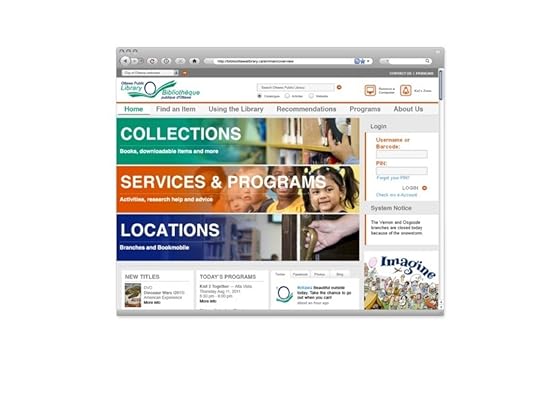
Here is the advice I received from the Ottawa Public Library about how to submit a book for consideration in their collection:
Guidelines for Local Authors
1. All materials should reflect the standards described in the library’s materials selection policy.
2. Authors who wish to have their books considered for selection may send a copy of the book to Collection Management. Books can be dropped off at the Info Desk at any branch and then sent by inter-library mail.
3. Please note that unsolicited materials will not be returned.
4. The author should include a cover letter with the following information:
- name, email, home address, and telephone number.
- It should be clearly noted whether the book is meant to be donated or purchased.
- If it isn't a donation, the cost and ISBN number should be included in the cover letter.
- Submissions with third party independent reviews are given priority. Reviews should be included with the submission.
- Collection Development Librarians will determine if the book will be added to the collection. Because of the large volume of queries and submissions, authors will only be contacted when an item is added for the collection.
One last thing for consideration, if you have a distribution network set up, try joining the Independent Book Publishers Association and taking part in their library marketing programs.
Gook luck reaching out to libraries and building your network one book & one library at a time!
Stacey D. Atkinson is the author of the newly released novel Stuck, which she published via her independent company Mirror Image Publishing.
October 18, 2013
Book club kits...for authors
This week, I thought I'd share some ideas for authors on how to assemble a book club kit, which will give readers an enjoyable and memorable experience while discussing your book. As it turns out, I've been invited to speak at a local book club next month, so in the next few weeks I'll need to put together a book club kit of my own. After researching all kinds of ideas, I've narrowed down my list to the following...
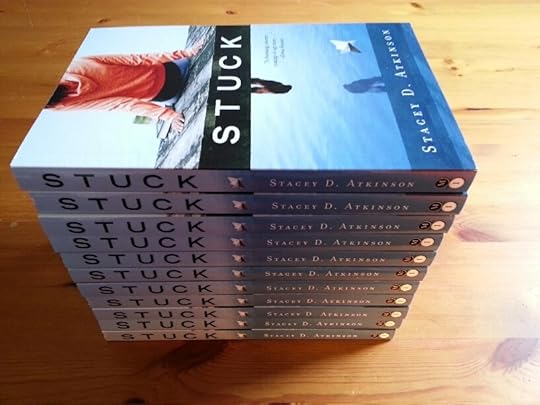
1. Create an online landing page for your book club kit, preferably on your author website, where you can host all kinds of resources for readers to learn more about you and your book.
2. Prepare a readers’ guide including an author bio, book reviews, and discussion questions. Also, consider adding fun add-ons that relate specifically to your book, such as recipes, maps, etc.
3. Record a short video of you, the author, talking about the book and link to it from the landing page on your website.
4. Create a fun quiz so people can test their knowledge about the characters and setting, or link to a quiz that you've created on another site such as the Goodreads quizzes page.
5. Offer to Skype in to the book club conversation, or even better, attend the book club meeting if it's in your home town.
6. Offer up a list of what to read next, which can include other books by you or similar authors.
7. Include a tip sheet for the host/hostess on how to run a great book club.
8. And lastly, consider approaching the staff at your local library to see if they'd be interested in promoting a local author book club kit.
Also, here's a handy article Personality Sells Books on the author-friendly Bookbaby blog.
Good luck building your book club kit!
Stacey D. Atkinson is the author of the newly released novel Stuck, which she published via her independent company Mirror Image Publishing.
October 11, 2013
Alice Munro...yay!
Let's all take a moment to celebrate Alice Munro! At 82 years old, she became the first Canadian to win a Nobel Prize in literature. When she learned of the news earlier this week, it's reported that she was completely surprised she had won and really didn't see it coming. What an amazing way to cap off a life-long career of writing great Canadian stories.
A few weeks ago, I also blogged about writer Margaret Atwood after seeing her speak at the Ottawa Writers Festival. At 72, she's just as witty as ever--even better!--and she exuded her trademark confidence and exceptional talent, making us all remember just how much she has contributed to the Canadian writing scene.
Combined, these two writers have published hundreds of poems, short stories, and novels, but the question I keep asking myself is: How come I've only read a handful of their work? How can two writers be so prolific and celebrated around the world, yet I only know a fraction of what they do? And how can I call myself a writer if I don't know my history!
Now I have a new agenda: I'm going to start at the beginning and read the first published works by both Atwood and Munro, as a way to follow their journeys on how they became such world-renowned writers. Then I'm going to keep reading and learning the techniques behind their craft. I want to learn how to tell a good story.
I remember watching the Juno Music Awards a few years ago and seeing Sylvia Tyson give an impassioned speech about how new recording artists need to listen to the recordings of their predecessors, especially from the 50s and 60s, to learn about the roots of popular music and to understand where it came from and how it can be mastered. I never forgot her speech and now I think about it in terms of writing. If I want to be a better writer, I don't need to pave a new road ahead of me. I can look back to the masters, like Atwood and Munro, and learn from the best.

Photograph copyright Kim Stallknecht
Stacey D. Atkinson is the author of the newly released novel Stuck, which she published via her independent company Mirror Image Publishing.
October 4, 2013
Après book launch...now what?
I spent the last week basking in the glow of two great book launches that took place at Chapters Moncton and Chapters Ottawa (Canada). I rarely take time to celebrate my success--I usually just move the goal post farther down the field and keep on working--but in this case I took the week to really reflect on the launches and to figure out what to do next to keep the momentum of book sales going strong.
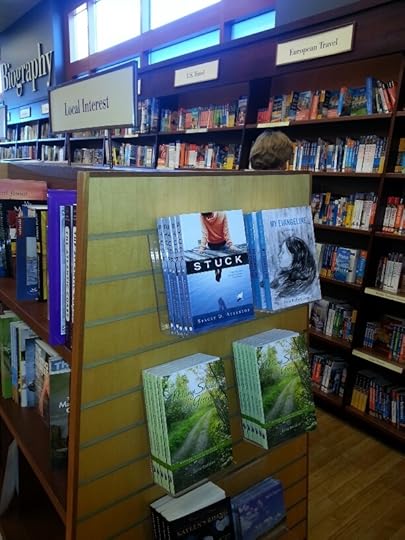
Let me start by saying that I had no idea just how much I would enjoy the book signings. Most of the blogs and tip sheets I'd read gave the impression that it would be an uncomfortable selling job--a hard task for authors used to working in solitary confinement day after day. But I prepared for the worst and hoped for the best and ended up having an amazing time selling lots of books and loving every minute connecting with friends and fans who came to the events. I was actually quite humbled by the whole experience.
Now on to the next chapter...what do I do now? I spent so much time planning (and worrying) about the launches that I'd failed to see beyond them and how to keep up the marketing momentum. If there's one thing I know to be true, it's that books do not sell themselves. You need a strategic marketing plan--one that's well-researched, well-timed, and with a realistic budget. I spent some time mapping out my ideas and came up with the following après book-launch promotions, which I think could be helpful to a lot of new authors:
1. Blog Tour: A few months ago I did some research that led me to believe that a blog tour would be a big waste of time. However, I recently spoke with a publicist at Smith Publicity and she told me to absolutely go for it, especially since I write fiction, which lends itself well to this type of marketing. It takes about 4-6 weeks to organize a tour, but she convinced me that it would help to build buzz even if it didn't convert immediately into book sales. Check out this BookBaby blog for tips on setting up a virtual book tour.
Cost: free plus book giveaways
2. BookBub: This online company offers a 'daily deal' email for digital books, sent every day to its over one millions subscribers. Publishers offer amazing deals to get their titles discovered and pay a small advertising fee to BookBub to promote the book as either free or deeply discounted with amazing results. The company claims that a free book earns an average 14,200 downloads and a $0.99 book achieves and average 1,130 sales.
Cost: $140-$280 for a fiction book
3. Book Club: With the approaching winter months as people are hunkering down for hibernation, it's a great time to pitch your book as a perfect book club read. Offer a Q&A, video clips by the author, and use #bookclub in social media posts. Also, create a dedicated book club page on your website.
Cost: Free
C'est tout...keep on carryin' on, folks!
Stacey D. Atkinson is the author of the newly released novel Stuck, which she published via her independent company Mirror Image Publishing.
September 27, 2013
Margaret Atwood is disorganized
On Tuesday evening, I had the opportunity to attend a keynote talk by Margaret Atwood as part of the Ottawa Writers Festival. Hundreds of attendees filled the pews of Southminister United Church to hear one of our country’s greatest icons sermonize us from the altar.
I have to admit, I was pretty excited to be there. Yes, I am a fan of Ms. Atwood’s work, but it was more than that. I was anxious for gold nuggets. These are the little bits of advice neatly wrapped up within the contents of a presentations, offering a word or two of wisdom that I can take away with me to help with my own career goals.
For someone like me who is new to the writing and publishing game, having the opportunity to hear Ms. Atwood speak with 50 years experience as a writer was an awe-inspiring opportunity, to say the least.
When she finally took the stage, I could feel that I was about to have a spiritual awakening. Within the first 5-minutes, she sang a gardener’s hymn to honour the fact that the festival was taking place in a church, then she gave a reading from her new novel MaddAddam in which she called one of her characters a 'fucker’. At that moment, I knew Margaret Atwood was awesome.
Over the next hour, Ms. Atwood shared with the audience some insights into her new book, as well as thoughts about her writing process. She was unfailingly honest in her views and her dry humour kept us all laughing and entertained. When her talk was over, it felt like only 5 minutes had passed.
As expected, her talk was full of gold nuggets, a few of which I’ll share with you now.
1) You can be disorganized and still write best-selling books. Margaret Atwood says she's the most disorganized person around, but it's okay to be a disorganized writer as long as you respond to inspiration when it hits by jotting down ideas on scraps of paper and keep them all in a pile or two for easy access (*see note below)
2) Our childhood upbringing will factor into our stories and that’s okay--write what you know. For example, Margaret Atwood always had a fascination with Easter eggs, which is why many of her stories, including the cover design of MaddAddam, feature eggs in them.
3) It’s okay to write in different genres. I’d always heard it’s best to stay in one genre in order to keep your fan base, but Margaret Atwood has had wide and varied career from writing poetry to dystopian fiction, and now she’s even talking about writing a thriller!
4) Use caller I.D. so that you won’t pick up the phone to a telemarketer when you’re writing!
Note: Here’s a photo I took of a diagram I created for my next novel. Now that I've heard Margaret Atwood speak about how disorganized she is and how she’d never use a diagram to plot out her characters, setting, etc., I think it’s kind of funny how serious I was when I made this, thinking this must be what all great authors do. Ha!
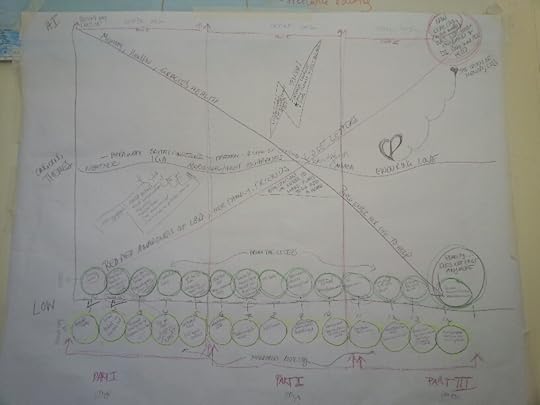
Stacey D. Atkinson is the author of the newly released novel Stuck, which she published via her independent company Mirror Image Publishing.




